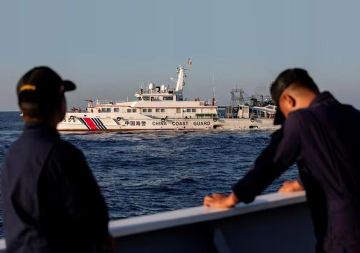
At the Raisina Dialogue 2019, the discussion in a panel on ‘Emerging Maritime Geometries’ was all about China’s growing naval profile in the Indo-Pacific region. The panellists—consisting of five defence chiefs from India, Australia, France, Japan and the United States—found themselves taking hard questions from a probing moderator and an inquisitive audience. The essence of most queries was the same: How do Indo-Pacific navies plan to deal with the People’s Liberation Army Navy’s (PLAN’s) expanding footprint in Asia?
As the speakers were all uniformed personnel – bound by service rules and protocol—there was hardly any expectation of surprising revelations. Even so, the military leaders were clear in stating their anxieties about growing Chinese power in Asia. Admiral Sunil Lanba, the Indian naval chief, observed candidly that the PLAN is already an ascendant force in the Indian Ocean. Not only is Beijing spending huge sums of money on the development of military capability, it is also modernising the PLA’s command structure. He noted that the pace of naval modernisation (with over 80 ships commissioned in the past five years) and the pattern of its recent operations, shows that the “PLAN is a force which is there to stay”.
China’s construction of a military base in Djibouti served as the starting point of a discussion on the PLAN’s power projection in the Western Indian Ocean. Admiral Christophe Prazuck, the French naval chief, observed that China’s Indian Ocean activism must be seen in the context of the region’s peculiar geometry – its ‘dots’ (choke points), ‘SLOCs’ (sea-lanes) and ‘stocks’ (of fishes, hydrocarbons, and minerals). The French navy, he observed, is closely watching the emerging dynamic, and is making plans of its own. This includes a robust engagement programme with the Indian navy, the first step of which is a joint operation involving French aircraft carrier Charles De Gaulle and Indian naval ships in the Indian Ocean later this year.
Admiral Kutsutoshi Kavano, Chief of Staff, Joint Staff, Japan Self Defence Forces, shared India’s and France’s concerns about China’s aggressive strategy in the Asian seas. He said that while Japan’s real conflict with China is in the East China Sea, Tokyo is obliged to contribute to the security of the South China Sea. Despite restrictions imposed by the constitution on the SDF, said Kawano, important legislation has been amended to allow the Japanese navy to act in collective self-defence. Following robust economic growth, Tokyo is even willing to share the burden of East Asian security with Washington.
For General Anjus Campbell, the Chief of Australian Defence Forces, Canberra’s priority is to build a community of stakeholders in the Indo-Pacific. Far from serving any national ambition for strategic preeminence, Australia’s partnerships in the Western and Southern Pacific as well as the Indian Ocean are aimed at serving the interests of all regional states. Admiral Philip Davidson, the US Indo-Pacific Commander, emphasised security and prosperity in the shared littorals of the Indo-Pacific region, where the US navy was prepared to collaborate with all regional partners to implement a free, open and inclusive ‘rules based order’.
Expectedly, many of the questions from the audience concerned China’s military muscle flexing in the Indian Ocean. For many Indian observers, China’s naval expansionism is a key driver of China’s ‘unilateralism’ in South Asia. China’s Belt and Road projects seem a strategic precursor to PLAN military bases in the Indian Ocean. With Beijing stepping up naval shipbuilding in recent years – including aircraft carriers – it seems the PLAN is intent on increasing strategic reach in the far-seas. Recent reports suggest that of the six aircraft carriers that Beijing plans to operate in the future, two will be deployed in the Indian Ocean Region. China’s second flattop, the Type 001A, is due for commissioning in 2020 and a third aircraft carrier, the Type 002, is under construction in Shanghai.
It comes as no surprise that Japan and the US have been deploying their own aircraft carriers into the Indian Ocean Region. The Japanese helicopter carrier JS Kaga visited Colombo last year, and the USS John C Stennis established a temporary air logistics hub in Sri Lanka to receive support, supplies, and services.
What is worrying is that India, the region’s principal security provider, is still playing catch-up. The Indian navy’s indigenous aircraft carrier (IAC-1) has been facing chronic delays, with plans for the IAC-2 on the backburner—following steadily declining budgets, technological hurdles, and enduring holdups by the Ministry of Defence. Despite Admiral Lanba’s assurances in recent weeks, there is fear that the third aircraft carrier could be indefinitely delayed.
The bigger challenge for India comes from the presence of Chinese submarines in the Indian Ocean. China’s anti-piracy contingents in the Western Indian Ocean are now invariably accompanied by a PLAN submarine. These Chinese subs are known to regularly conduct patrols in India’s near seas, collecting critical operational information. India’s naval leadership has moved to ramp up surveillance, with P-8I reconnaissance aircraft effectively teaming up with US P-8A in the near-seas. Yet, it is not clear if the Indian navy is more successful than earlier in detecting Chinese submarines. Recent Indian initiatives, such as round-the-year deployment of “mission-ready warships” near chokepoints in the IOR, an information-sharing pact with Japan, and a new ‘fusion centre’ in Gurgaon – while helping create better domain awareness – are unlikely to have contributed to the cause of PLAN submarine identification in the near-seas. Unfortunately, India’s underwater surveillance plans have still not materialised. The indigenous submarine programme is facing delays, and a rumored proposal for a wall of undersea microphones in the Southern Bay of Bengal has been seemingly abandoned.
New Delhi’s continuing wariness with a ‘maritime-Quad’ has not helped matters. Despite recent improvements in the Malabar exercises with the US and Japan, the engagement still does not include Australia, a key partner in the Indo-Pacific. At the Raisina Dialogue, Australian foreign minister Marise Payne, made a compelling presentation of her country’s Indian Ocean priorities. But Delhi’s ‘hedge-and-engage’ approach towards China does not appear to allow for an accommodation of Australia in the Malabar.
Unsurprisingly, no one on the panel quite had an answer for why -- even as the PLAN freely leverages its ‘places and bases’ in the Indian Ocean -- does the ‘Quad’ not have a military component.
The views expressed above belong to the author(s). ORF research and analyses now available on Telegram! Click here to access our curated content — blogs, longforms and interviews.




 PREV
PREV


